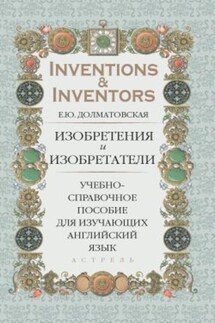Изобретения и изобретатели. Учебно-справочное пособие для изучающих английский язык - страница 2
The word used for ballpoint pens in Argentina is birome because Laslo Biro lived there for many years; also, biro can be used to refer to a ballpoint pen in British English. It was originally invented for the British RAF (Royal Air Force), as problems occurred with fountain pens due to the low air pressure aboard planes in flight. Ballpoint pens are still widely referred to as a biro in many countries, notably several European countries, the UK, Australia and New Zealand. Argentina’s Inventor’s Day is celebrated on Biro’s birthday.
Soft-tip pens that use points made of porous materials became commercially available during the 1960s. In such pens a synthetic polymer of controlled porosity transfers ink from the reservoir to the writing surface. These fibre-tipped pens can be used for lettering and drawing as well as for writing and may be employed on surfaces such as plastic and glass.
Words
ballpoint pen шариковая ручка
fountain pen перьевая авторучка
marker pen маркер
tip кончик
socket гнездо, углубление
biro 1) «Байро» (фирменное название шариковых ручек компании «Байро Бик» [Biro Bic]) по имени изобретателя; 2) шариковая ручка (разг.)
erasable стираемый
Complete the table using information from the text
a. Write a few paragraphs (one or three) about the inventions you have read about. Use the table above as a support.
b. Answer (in written) the question: “How could we live without a pen?”
a. Describe (orally) a pen that you wish someone could invent for you.
b. If you think you could do it yourself say how.
1.4 Typewriter
A typewriter is a mechanical, electromechanical, or electronic device with a set of “keys” that, when pressed, cause characters to be printed on a document, usually paper.
A typewriter has a keyboard, with keys for each of the characters in its font. The method by which the typewriter actually marks the paper now varies as greatly as types of computer printers do, but until the end of the 20th century was by the impact of a metal (or, later, metallized plastic) type element against an “inked” ribbon which caused ink to be deposited on the paper. Carbon paper was sometimes inserted between multiple pieces of paper, so the impact also caused duplicate characters to be printed on each layer of paper. The invention of various kinds of machines was attempted in the 19th century. Most were large and cumbersome, some resembling pianos in size and shape. All were much slower to use than handwriting. Finally, in 1867, the American inventor Christopher Latham Sholes read an article in the journal Scientific American describing a new British-invented machine and was inspired to construct what became the first practical typewriter. His second model, patented in 1868, wrote at a speed far exceeding that of a pen. It was a crude machine, but Sholes added many improvements in the next few years, and in 1873 he signed a contract with E. Remington and Sons, gunsmiths, N.Y., for manufacture. The first typewriters were placed on the market in 1874, and the machine was soon renamed the Remington. Among its original features that were still standard in machines built a century later were the cylinder, with its line-spacing and carriage-return mechanism; the escapement, which causes the letter spacing by carriage movement; the arrangement of the typebars so as to strike the paper at a common centre; the actuation of the typebars by means of key levers and connecting wires; printing through an inked ribbon; and the positions of the different characters on the keyboard, which conform almost exactly to the arrangement that is now universal. Mark Twain purchased a Remington and became the first author to submit a typewritten book manuscript.


